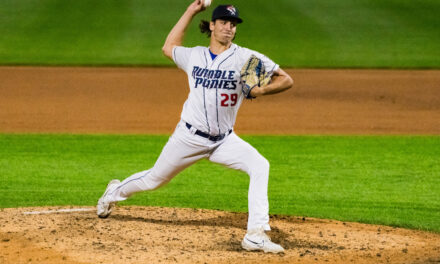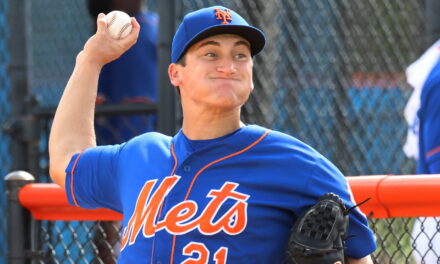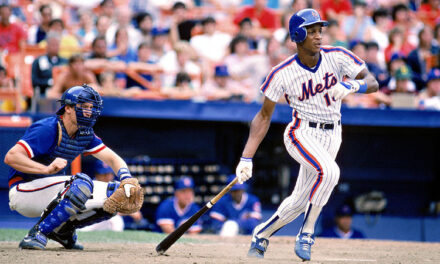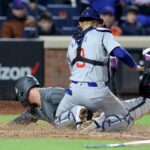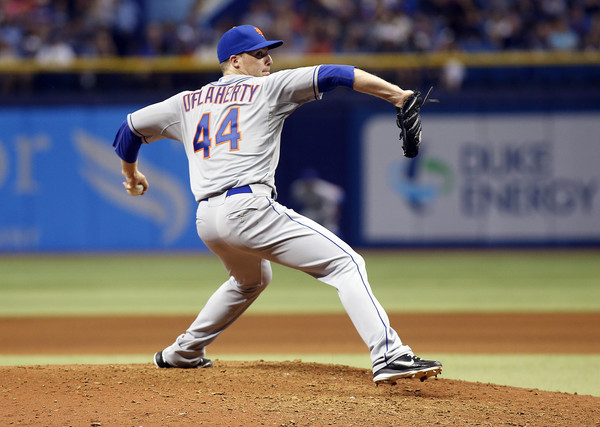
From 2009 through the 2012 season, left-handed reliever Eric O’Flaherty was one of the most effective and heavily used pitchers in the game.
O’Flaherty, 35, appeared in 276 games in that stretch, good for a four-way tie for the seventh-most appearances in baseball. Among qualified relievers, O’Flaherty’s 1.95 ERA was the fourth-lowest behind Craig Kimbrel, Mariano Rivera and Mike Adams.
A groundball pitcher, O’Flaherty’s 58.3% groundball rate was the 14th-highest among 211 qualified relief pitchers.
The 2011 season was O’Flaherty’s finest, one in which the Washington state native posted a minuscule 0.98 ERA in 78 appearances. He became the first pitcher in major league history to post a sub-1.00 ERA in 70 or more games pitched.
O’Flaherty made up a third of the Braves’ vaunted backend of the pen in 2011, joining Jonny Venters and the aforementioned Kimbrel. All three relievers appeared in at least 78 games and posted an ERA no higher than 2.10 that season.
It was only the second time that three relievers on the same team appeared in 75 or more games while posting an ERA no greater than 2.10, joining the 2003 Los Angeles Dodgers (Eric Gagne, Guillermo Mota and Paul Quantrill).
After his successful four-year run, O’Flaherty appeared in only 19 games with the Braves in 2013 before undergoing season-ending Tommy John surgery.
In late January 2014, the Oakland Athletics signed O’Flaherty to a two-year, $7 million deal. He made his season debut on July 4 and posted a 2.25 ERA in 21 games in ’14 before regressing in his second season with Oakland, appearing in 25 games and recording a 5.91 ERA.
Control issues plagued O’Flaherty in ’15, as his walk percentage spiked to 11.3% after never exceeding 8.3% the previous four seasons. He also appeared to run into some poor luck in ’15, as his .388 BABIP was the second-highest among relievers with a minimum 30 innings pitched. The highest BABIP O’Flaherty had during his peak dominance from 2009-12 was .292.
When asked about his struggles post-Tommy John surgery, O’Flaherty recalls expecting to have the same endurance and ability to recover post-surgery. Instead, O’Flaherty wore his arm out.
On August 4, 2015, O’Flaherty was on the move, being dealt with cash to the New York Mets for a player to be named later (Dawrin Frias). Unfortunately, the results weren’t much better heading back to the N.L. East, as O’Flaherty allowed 13 earned runs in 8.2 innings pitched, and didn’t fare well against left-handed hitters in a small sample size (.419 wOBA, 2.47 WHIP). He did not make any of their postseason rosters.
Following the ’15 season, O’Flaherty inked a minor league deal with the Pittsburgh Pirates before reuniting with the Braves in a trade before the start of the 2016 season. He spent his final two major league seasons with the team he had the most success with, appearing in a total of 61 games and faring better against left-handed hitters (3.04 FIP, 1.06 WHIP, 20.0% strikeout rate).
O’Flaherty has kept himself involved in the game post-retirement, as he co-hosts a podcast on The Athletic’s website called 755 Is Real, with writer David O’Brien. The pair records multiple episodes each month on various topics going on in Major League Baseball, with a specific focus on Braves-related matters. Special guests like Chipper Jones, Dale Murphy and Ken Rosenthal have also appeared with the duo.
I had the privilege of speaking with O’Flaherty, where we discussed the culture of not wanting to disclose injuries as a young player, his incredible 2011 season with the Braves and the trade that sent him to the Mets as they made their playoff push in 2015.
MMO: Who were some of your favorite players growing up?
O’Flaherty: Ken Griffey Jr. and Randy Johnson. I grew up in Washington state so it was mainly all Mariners like A-Rod. That was kind of my generation of players I was looking up to. And Sandy Koufax, too.
MMO: At what point during your development did you start to think that baseball might be a serious career to pursue?
O’Flaherty: It would’ve been my junior year. I talked to Oregon State a little bit but didn’t really get much attention past high school at that point.
I went and pitched in a tournament in Arizona and wound up throwing 92-93 mph for a few innings. It was a scouting tournament, I was playing for a team called Baseball Northwest and we went out to this tournament in Arizona. After I did that it was basically non-stop attention from scouts and colleges. That kind of made it like there was a legit shot there.
MMO: During a podcast interview, you spoke about the vast differences in culture between the Seattle Mariners and Atlanta Braves. Can you expand a bit on those differences and how going to the Braves organization was a boon for your career?
O’Flaherty: Mainly it was just that there were some characters in Atlanta that just went out of their way to let you know that you belonged and really tried to pump you up like Bobby Cox, Brian McCann and David Ross.
Playing for Bobby was just kind of a game-changer for me. He had this way of any time he knew that you needed a pick-me-up he’d give it to you in a subtle way that would make you think Man, maybe I’m not as bad as I think right now.
The big thing for me was I was pretty immature when I was with Seattle so I kind of built not the best reputation for myself. Sometimes going to a new organization gives you a chance to leave some of your bad habits in the past. It’s a clean slate and nobody really has any assumptions of who you’re going to be or who you are or anything about you really. They just know that you’re left-handed and have a good arm.
It’s the same kind of concept with when you struggle in front of a fanbase or in front of coaches and stuff like that; it’s really easy to get wrapped up in that “here we go again” mindset. Even if it’s not you thinking it, you can sense it with people around you.
So, you get less time to struggle before those thoughts and feelings kick in. And sometimes just going to a new organization gives you that clean slate and fresh start, and that’s a big thing for a lot of guys and it was for me for sure.
MMO: You also expressed in that podcast how going from Kenji Johjima in Seattle to Brian McCann and David Ross as your catchers were crucial in your development. What was it about McCann and Ross that made things click for you?
O’Flaherty: There was a language barrier with Johjima. He had to use a translator and I don’t know if it’s a knock on him as much as the way McCann and Ross could communicate. These guys were just masterminds of getting the most out of their pitchers and making you feel confident; showing you all of the scouting reports and all the different stuff.
Being a rookie in Seattle, you’re not ready to call your own pitches and do all these things yourself, so once I got to Atlanta I had these two guys that were basically quarterbacks back there. I could just hit my spot and I was good.
They really simplified things for me to not have to second guess or think about anything. I just threw whatever they called.
MMO: You hurt your back during Spring Training in 2008, and on the Baseball America podcast “From Phenom to the Farm,” you talked about how the culture back then was a younger player shouldn’t be in the trainer’s room or speaking up about injuries. I remember you saying that a doctor told your wife that it’s possible that you’d never pitch again.
What was it like working back from that injury while trying to navigate that culture in the clubhouse?
O’Flaherty: Yeah, that’s just the way it was back in the day. I think a good thing that’s happened in the game is that it has really come a long way in that aspect of if guys are having any kind of minor injuries, the training staff wants to address it before it turns into something big.
It wasn’t necessarily a training staff thing back then, but it was just a culture of if you’re a young guy you shouldn’t be in the training room. So, if that’s the deal, I wasn’t going to be in there.
What wound up happening was I hurt my back – I think I was squatting or doing something one day – and I irritated it and I just kept pushing it and pushing it and not really saying anything. I didn’t want to be a young guy that was hurt and the main motivation for me was I was looking at my first Opening Day roster. That’s just a special thing to get to do.
So, not calling it greedy, but really just wanting to be on that roster so bad, I kind of masked it and didn’t really say anything and just kept pitching.
It gradually just got worse and worse and worse until the point where I just couldn’t throw. And obviously, I wasn’t throwing very effectively at the time, so I shouldn’t have pitched in the first place.
It’s one of those things that now teams really encourage guys if there’s anything wrong to get into the training room. And not a lot of the vets will give you too much crap because they’ve been through it too. Back then it was just a different culture.
MMO: And what was the process of rehabbing like for you?
O’Flaherty: I spent most of the summer just waiting for it to get better and finally Dr. Herring, a really good Seattle doctor said, “You can’t just sit. It’s not going to get better if you sit. There’s this rehab facility in downtown Seattle that I want you to go try.”
It was called Olympic Physical Therapy and they had a side of it that was called Athletic Engineering and they were all about working on your transverse abdominis and getting the right muscles firing to support your back, activating your glutes, doing all this little stuff.
It started out just standing on one foot and looking at one wall and then looking at another direction at another wall and just doing basic stuff like that. Kind of training your body on how you should be stabilizing and things like that.
I was doing that and I had already been told that I had two herniated disks and a cyst growing into my spine and I’m spending all these days standing on one foot looking around and I was like Well, this is a wrap, but I’ll keep doing it. [Laughs.]
You’re at the point where you’re limited to just standing on one foot and looking around and it wasn’t looking too bright. But I stuck with the program and it eventually by around November of that year – I got shut down in early June – and by November I was throwing again off the mound. And that’s when I got claimed by the Braves.
MMO: It’s pretty incredible to think about that injury and rehab when you consider that from 2009-2012 you appeared in 276 games with the Braves. You were in a four-way tie for the seventh-most appearances by a reliever in that stretch.
O’Flaherty: I really think being young and dumb helped with that a lot. If you get told something like this at 28 or 30 and you understand odds and understand how certain comebacks are and things like that, but I just didn’t know any better. I didn’t have anything else to do.
My wife and I look back on that summer all the time and we weren’t worried about our future at all, we just enjoyed the summer. It’s kind of crazy to think that anything could’ve happened with that injury. I just think being young and dumb and kind of naïve that my career was on the line, and understanding how the world works and that you need a job and you’ve got to make money, just being naïve to all of that I think was a huge benefit for me.
MMO: Your 2011 season was one for the ages. You made 78 appearances and posted an ERA of 0.98 with a 1.086 WHIP. You became the first pitcher ever to post a sub-1.00 ERA in 70 or more appearances. Was there anything you changed or altered mechanically or physically that season?
O’Flaherty: No, I was just locked in. I started training with my trainer in Seattle and he got me healthy at that Athletic Engineering place. I just kind of took his program each year and we advanced it athletically and added more and more dynamic stuff to it. And really, my body was functioning so well because I was so scared to hurt my back, I just did his program religiously.
It was a forty-minute warm-up every day that I did, and then I had about an hour workout after every game. It wasn’t heavy stuff, it wasn’t crazy weights or anything, but it was mentally challenging because you had to really focus on where you were in space and stuff.
My body control was just really, really good so I could repeat my delivery and hit spots. It was just one of those freak years, man. I caught some lucky breaks too and everything just kind of came together.
MMO: What were your initial reactions to getting traded to the Mets back in August 2015?
O’Flaherty: Man, I was jumping for joy. I got designated for assignment and I packed up my apartment in San Francisco and drove home. It was just the easiest way to get out of there and get all of our stuff back to Seattle because I didn’t know where I was going.
We drove twelve or thirteen hours home up to Seattle and kind of started unpacking. The next day I was like Shoot, I’ve got to go throw and get some work in. We had gotten in at like six in the morning because it took a while to pack up and whatnot. But I got in at around six and at five o’clock I was getting a workout in and throwing. I just finished my workout and I was leaving the gym and I got a call from Sandy Alderson saying, “Hey, you’re a Met now.”
I knew they were in the playoff hunt and I just was jumping for joy in the parking lot! I got in my car, drove home and started sorting through all of those bags that were in my garage from the other apartment trying to pack for a couple of months to go be a Met. And then the next morning I had a six a.m. flight to Miami.
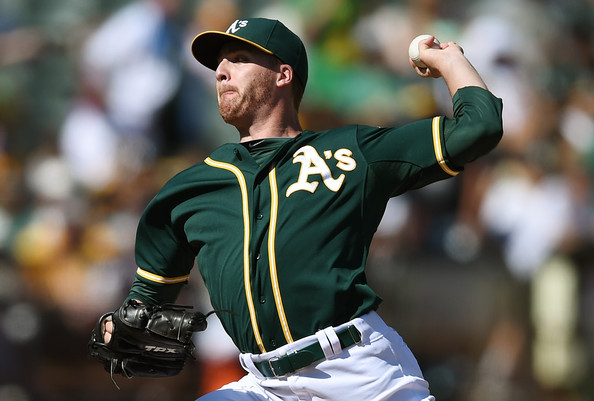
MMO: Fans will often overlook the impact of getting released or designated for assignment on a player, his psyche, and family. Can you talk about going through that and not knowing where you were heading to next?
O’Flaherty: I mean it hurts, it hurts your ego obviously. I kind of knew it was coming because I was struggling with Oakland for months. I was just having a terrible year as it was and I knew something would probably happen soon.
When the trade deadline passed I kind of thought that I was going to stay there. I figured if they wanted to trade any kind of pending free agents that had – I didn’t have much value, honestly – but maybe unload some of the salaries or whatever [at the deadline]. I was kind of prepared for something to happen and nothing did.
Then about three or four days later I got called into Bob Melvin’s office and he let me know what they were doing and that they were calling up a starting pitcher and needed the spot. And no hard feelings there, I was terrible. I was kind of expecting it.
It hurts your pride; it hurts your ego even if you know it’s coming. It’s not fun to deal with but you try to be a pro about it and I packed all of my stuff up, told everyone goodbye and that’s when my wife was home in Seattle. We had a one-year-old and she was getting him out of the house for a little while and she flew out to San Francisco and we drove home.
I was just trying to stay ready, but you don’t really know what’s going to happen next, but you need to be ready. I just tried to have a positive outlook and figured if anyone was going to pick me up it was obviously going to be a playoff contender. I kind of looked at it like this will be a positive because nobody is going to bother with my skillset unless they need someone to get lefties out in the playoff stretch.
I didn’t think it was that hard mentally not really knowing where I was going but physically it was pretty exhausting driving home from San Francisco, which no one made me do, and then flying across country to Miami to be ready for a game that night.
MMO: Even though you only made 16 regular-season appearances with the Mets, did you like pitching in New York?
O’Flaherty: Man, I loved it! Honestly, as crazy as that sounds because I was the worst pitcher for us, I actually really enjoyed the experience a lot. The way that the organization treated me, the way that the fans treated me – especially at first before I started sucking – and just getting to go through that experience of being a New York ballplayer. It’s just one of those things that I’m really glad it happened in my career.
Even though the circumstances didn’t go how I drew it up, it was still just a really cool experience to get to be a Met for a little while and just see how crazy and into it New York fans are.
MMO: If I remember correctly, Terry Collins didn’t just utilize you as a lefty specialist. You faced 19 right-handed hitters and they posted a slash of .400/.526/.800 against you.
O’Flaherty: Yeah, well I don’t think that’s what they wanted me to be was just a lefty specialist. But I also wasn’t pitching in close games by the time he was using me against righties, and that’s kind of one of the things: If you want to be a lefty specialist you’ve got to get the big outs against the lefties in the tie games.
I think towards the end of it he was just trying to find any way to get me in the game and see if I could maybe get it going for the playoffs because they wanted me to be able to get lefties out. But I was doing so bad that I think he was just trying to try anything at the end there. [Laughs.]
MMO: You underwent Tommy John surgery in 2013. Did any of that play a role in your struggles?
O’Flaherty: It was weird because the first year back I was protected; they wouldn’t throw me in back-to-back games. If I got up two days in a row I was going to be down, so they were really careful with me.
I think the big mistake I made was I expected to have the same endurance and recovery abilities that I had before Tommy John surgery. I expected going into 2015 to just take the ball every single day; I wasn’t going to ask for a day off.
I really didn’t adjust well and part of it was aging obviously, but also having a surgically repaired elbow that just wasn’t the same. I didn’t adjust very well to having to maintain it and give it sufficient recovery time. I struggled in ’15 because I was just wearing my arm out and not even really knowing it. I was doing what I always did but that had led me to have Tommy John in the first place.
MMO: It has to be difficult to readjust your training regimen and overall mindset after an injury when you’re so used to performing in a certain way and your body isn’t necessarily responding.
O’Flaherty: For sure. And like I said, I wanted to long toss and I was always trying to build up arm strength and throw lots of bullpens to find it and get it back. What I really needed was probably just rest and a mental break.
Probably the hardest thing was I was trying to make a lot of mechanical changes in the middle of a playoff run and you can’t be thinking about mechanics on the mound. I got into the habit of doing that since I came back from Tommy John – trying to feel like I felt before the surgery instead of just moving on and focusing on the game.
It probably wasn’t the best timing career-wise to be there, and I tried to make those adjustments in a playoff run, but I got to see some really cool stuff. I’ve never seen a player do what Yoenis Céspedes did those two months that I was there. I’ve never seen a player hotter than that and that was incredible to see!
MMO: For your career was there a batter that sticks out to you that gave you fits? Conversely, was there a batter that you felt you owned? Ryan Howard immediately comes to my mind (3-for-23, 9 SO).
O’Flaherty: Yeah, the thing about Ryan Howard was even when I sucked, he would line out. Even when I faced him when I was with the Mets and couldn’t get a four-year-old out, he would crush a ball and it would be right at somebody. It would just find a glove somehow.
The opposite was Joey Votto, I hated facing him! He’s just so good at staying on the breaking ball from a lefty and you have to pitch him inside, but he won’t chase in there. He’s definitely the toughest lefty I’ve faced.
MMO: Were you someone that embraced and utilized analytics during your career?
O’Flaherty: Yeah, I’ll be honest, man, I kind of went on cruise control when I was with Atlanta because McCann and Ross were so prepared. I think that’s one of the reasons I did so well. Those guys were so prepared back there that you just threw whatever they called. I think I shook once my entire five years in Atlanta.
But I think the Rapsodo and a lot of these other analytical tools that they’re using are awesome because it gives you your spin angles, the break, everything that’s going on. It shows you how to kind of tunnel your breaking ball off your fastball better. Years where I couldn’t strike anyone out with my slider, I might’ve been able to fix that in two or three games versus months at a time.
A lot of times you feel like you’re doing something in baseball but you’re not. Having some kind of tool to measure, I think, is really valuable and can be pretty effective. It can also go the other way where you lose your feel because you’re so worried about how something looks on video or how a machine says the ball is spinning, or hey, congrats you’ve got way more spin on the ball but you’re casting your breaking ball and it’s not as effective against hitters.
That type of stuff can happen too, but I think there’s a ton of value in analytics and obviously, you can see that because so many teams are getting on board if they’re not already.
MMO: You co-host a podcast on The Athletic called 755 Is Real. How did that come about for you?
O’Flaherty: I was just hanging out one day and I got a text from David O’Brien who’s an AJC (Atlanta Journal-Constitution) writer. He’s been doing the Braves for quite a while and I always liked working with him, and he just texted me and asked if I wanted to co-host a podcast with him.
I had been retired for a year and not really doing anything too crazy and it’s only a couple of times a week and I said why not, let’s try it. And it’s been fun! We hit on some issues around the league some days and somedays it’ll just be purely Braves, but it’s always a lot of Braves stuff.
MMO: Have you given any thought to pursuing a career in sports media, or would you want to work in baseball as a coach or instructor in some capacity?
O’Flaherty: I ask myself those questions every day. [Laughs.] The tough thing about coaching is you’ve got to travel, and I’ve got two boys, so I don’t want to drag my family around. If they start school you have to be away from them so they can finish and you’re kind of living like a divorced family or like you’re living two separate lives.
I don’t really see myself wanting to do that unless the boys were just obsessed with it and wanted to be around the game. Maybe some kind of instructor or something like that.
On the media side, I would never want to do anything on TV because I feel like you have to be kind of fake and it’s not my style. Some guys it fits their personalities and they’re great at it, but for me, I feel like I’m too laid back to be all amped up and giggle at 9 a.m. on a Sunday morning.
MMO: What’s your take on the three-batter minimum rule?
O’Flaherty: That’s something I get asked about quite a bit and the LOOGY has pretty much been dead for a few years anyway. I think the change that happened was once teams started trying to protect their relievers, meaning they wouldn’t throw them three or four days in a row. The only way you can have value as a LOOGY is if you’re doing what I did sometimes, but also what Pedro Feliciano did for the Mets where you’re available for 85 games.
You can’t have a guy be down and only get one out anyway. You can’t have a guy like that in your bullpen, especially with starters going shorter outings now. The way the game changed was they don’t want starters facing the lineup the third time through, it led to you can’t have a guy in your pen that’s only getting one out at a time because you need more relievers available. And unless you’re going to let a guy throw 80-85 games, he really doesn’t have value. It’s a wasted roster spot.
I don’t know if it was necessary to do the three-batter minimum because I think a lot of teams were leaning towards getting away from it anyway. But for me, it’s whatever.
People ask me now if I would’ve had a career, but in my best years, I was facing guys from both sides of the plate nonstop. From 2010, ’11, ’12 I was facing an entire lineup and I always did better against lefties, but I could get righties out. I’d go through a spurt where I’d give up eight hits in a row to a righty and then I’d be back to normal in getting them out.
I think it’s something that’s not really a big deal but it wasn’t necessary either. It’s just kind of another one of those gimmicky changes to the game that we’re seeing that I don’t think are necessary.
If you’re a lefty and you want to stay in the game now, you’ve got to figure out how to get righties out and that’s what I think would’ve happened to me if I was just forced to have learned a changeup. I could kind of get away without one before because I could get favorable matchups and maybe some of the righties I would face would be bottom of the order guys. But I don’t feel bad for anybody, it’s the game now so you’ve got to adjust and figure out a way to stick around.
MMO: And what would be your advice to lefty relievers now?
O’Flaherty: It’s different for everybody. You’ve got to figure it out, it’s on you. The game doesn’t stop, and nobody is going to wait for you to figure it out; you can either do it or you can’t.
Usually, it’s a changeup or something going away from that opposite-handed hitter. For me, the sinker was a pretty good neutralizer and the best years that I had the sinker worked in my favor because righties would see a lefty reliever that was throwing 70-80 percent fastballs and then their swing would get big. They’d come up and think this is my moment and I’m going to do some damage, and I’d throw a sinker that started middle first pitch and they’d get a little pull happy and pull it right to the shortstop on the ground.
That really worked in my favor but you definitely need something going down and away from righties as a lefty and you’ve got to pitch inside, too. You see a lot of righties that struggle against lefties; it’s usually the changeup that’s the neutralizer but you can throw a cutter. It’s all a formula of your arm action, the angles you’re throwing at, velocity, things like that.
And it’s a confidence thing, too. The more you face the better you’re going to do and kind of get comfortable against that other side. That’s probably the hardest part about it is when you don’t face righties then how are you going to get them out? It takes some practice and work against them, and that’s one of the hard parts about being a manager is finding a way to get a guy to face some righties and you can’t do it with the game on the line and when it matters.
It’s just a different formula for every player but you’ve got to figure out that if you want to stay in the game now.
MMO: And that’s certainly where the technology and advanced metrics can come into play in aiding pitchers with learning a new pitch, changing grips, arm angles, etc.
O’Flaherty: Big time!
MMO: When you look back on your career, what are you most proud of?
O’Flaherty: Probably just the memories, man, and the friendships. Honestly, that 2011 season was awesome, but those five years with the Braves I just learned so much about life. I made a ton of really good friends that I’m going to keep for the rest of my life. It’s really just about the experiences, memories, and getting to travel around.
Getting to ten years of service, I don’t know what the numbers are on it, but not a lot of people have done that. My career really didn’t end the way I wanted it to, so it took some time to just kind of get away from it and be able to look back and be like, man, that was a pretty good career. It takes time to get that taste out of your mouth after you struggle for two or three years and kind of getting older and staying at home.
It took probably until early 2019 for me to really be able to look back and be proud of my career.
MMO: Thanks so much for some time today, Eric.
O’Flaherty: Thanks very much.
Follow Eric O’Flaherty on Twitter: @EOF34
Check out Eric’s podcast, 755 is Real, here.


